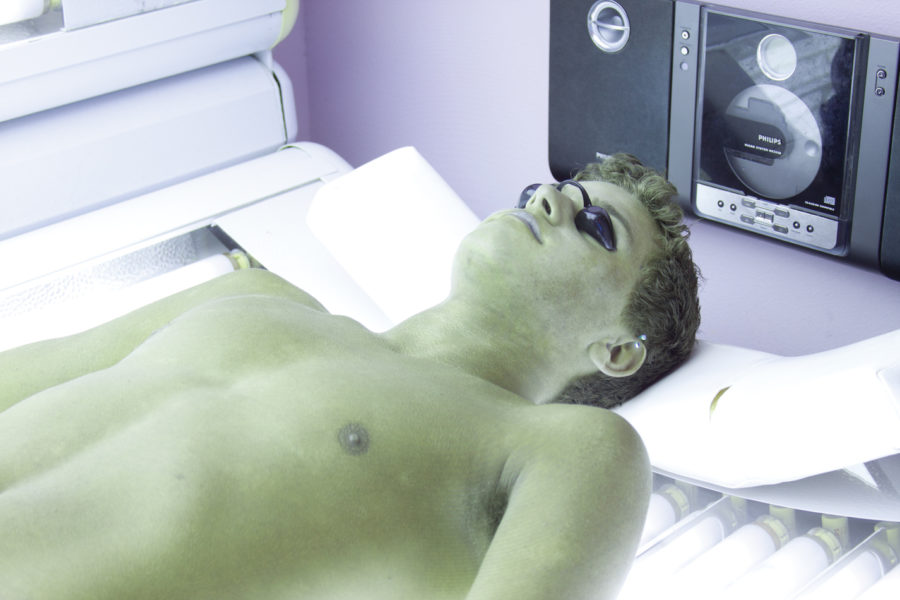Businesses face possibility of tanning ban on minors
Photo Illustration: Whitney Sager/Iowa State Daily
A new law in Iowa requires a parental consent form for anyone under the age of 18 wanting to use a tanning bed.
March 10, 2011
With spring break just around the corner, hundreds of students flock to tanning beds to bronze up. However, this may not be an option for minors much longer.
The American Academy of Pediatrics released a report supporting a ban that would prohibit the use of indoor tanning devices for any person under 18, even with parental consent.
Leslie Christenson, dermatologist and mohs micrographic surgeon at McFarland Clinic, said a tanning ban would help “decrease the rising incidence of skin cancer, but hopefully also the mortality.”
Tanning units can produce 10 to 15 times stronger ultraviolet radiation than the midday sun, according to the AAP report. The International Agency for Research on Cancer classifies UV tanning devices in the highest cancer risk category Group 1: carcinogenic to humans. Other agents in this category include cigarettes, mustard gas, plutonium, radon and coke production.
Currently, 11 states restrict minors from tanning and 31 states require parental permission. Last year, a 10 percent tax was imposed to indoor tanning. This tax does not apply to medical phototherapy services, spray-tanning and gym membership tanning.
The Indoor Tanning Association lists vitamin D as a positive effect of UV light. The organization claims “exposing the skin to ultraviolet light is the body’s primary means of producing vitamin D,” which in turn is related to positive physiological effects.
Christenson said the health risks of tanning far outweigh any health benefit claims.
“The UV in the tanning bed can result in some vitamin D production, but you can get adequate vitamin D production with the drinking of fortified milk, an oral supplement or 5 to 10 minutes of natural sun exposure three to four times a week,” she said.”
“As for mood benefits, there is evidence that serotonin, a mood-elevating substance, can be released with UV exposure; however, this can also be done with a good run, intake of chocolate or a good laugh.”
“Seasonal affective disorder is treated with visible light, not ultraviolet light that is emitted in the tanning bed. Visible light and ultraviolet light are two very different portions of the light spectrum.”
Austin Moody, manager at Sizzlin’ Cabana and ISU sophomore in pre-business, said a tanning ban wouldn’t have a deep impact on business since his business’ primary clients are college students.
He said tanning is “a great stress reliever. It’s 10 to 20 minutes of relaxation.”
The first few months of the year is the business’s peak season with nearly 200 customers per day. Moody said clients want to build a base tan before going on spring break.
“A tan is not protective, but is a sign of the body’s reaction to sun damage that has already occurred to the skin cell’s DNA,” Christenson said.
She said the idea of building up a tan in a tanning bed is “proof of damage and is not protective.”
Each Sizzlin’ Cabana client must complete an annual release form. The form lists the following health effects of tanning: “increased risk of skin cancer later in life, increased risk of skin thickening and premature aging, possibility of burning or rash, increased risk of eye damage unless proper eyewear is worn.”
Moody admits there are risks, but “the goal is to educate clients on the safe way to tan and create a friendly atmosphere where clients can ask questions.”
All clients must show eyewear and wait 24 hours between tanning. Moody said it’s important to “work with the law. We’re not trying to go against it.”
Lauren Young, junior in advertising, sees both the good and bad sides of tanning.
“It’s bad for you unless you take the necessary precautions,” she said. “I do believe it enhances your happiness. If minors have to have permission for everything else then they should have to have permission to tan. You don’t know or understand the risks when you’re that young.”
Electric Beach Tanning Center, tanworld and Fusion Tanning declined to comment on the issue.
Christenson said the most common warning signs of skin cancer are a red or shiny spot on the skin that won’t heal and/or bleeds easily, or a brown spot that changes in size, shape or color. In addition to skin cancer, overexposure to UV radiation can lead to premature skin aging, actinic keratosis or “skin growths,” cataracts and immune system suppression.
As students go on spring break trips, Christenson recommends frequently applying a sunscreen with an SPF of 30 or greater.







